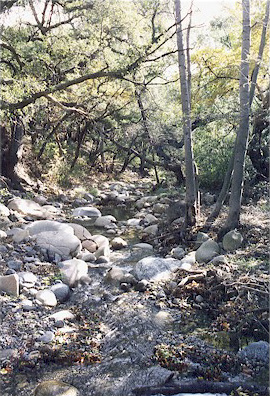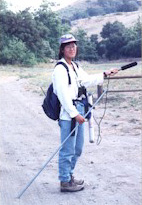Staff Research
Research
Starr Ranch has operated as a preserve of southern California wildlands since 1973. Our 4000 acres encompass the unique mosaics of mediterranean climate habitats that were once, before the spread of urbanization, typical of southern Californian landscapes: coastal sage scrub, grasslands (native perennial bunchgrass and exotic annual), oak woodland, chaparral, and riparian woodland. Until 2001, researchers on the Ranch came from universities and agencies all over the country. Since the inception of our innovative educational offerings, Starr Ranch Field Ecology Programs, in 2001, research has shifted to staff studies that contribute to Starr Ranch conservation and land management issues. Staff biologists have not only worked on projects that contribute to protection and restoration of the unique habitat mosaics at the Ranch but also have integrated their research into our education programs to provide both simulated and actual involvement in hands-on wildlife biology.
 At Starr Ranch, staff involvement in research applied to land management offers a multidisciplinary approach to meet the needs and solve the problems of Starr Ranch wildlands: exotic species invasions, restoration and enhancement of rare habitats, long term monitoring of populations of native wildlife, urban impacts, climate change effects. We aim to serve as a model of efficient, rigorous (i.e. science-based), and sustainable management and conservation practices for southern California ecosystems in the face of climate change.
At Starr Ranch, staff involvement in research applied to land management offers a multidisciplinary approach to meet the needs and solve the problems of Starr Ranch wildlands: exotic species invasions, restoration and enhancement of rare habitats, long term monitoring of populations of native wildlife, urban impacts, climate change effects. We aim to serve as a model of efficient, rigorous (i.e. science-based), and sustainable management and conservation practices for southern California ecosystems in the face of climate change.
Current staff research and initiation dates:
- Monitoring Avian Productivity and Survival (MAPS, 1999)
- Upland Invasive Species Control and Restoration (1997)
- Stream Bioassessment (2003)
- Riparian Invasive Species Control and Restoration (2003)
- Effects of Restoration on Wildlife (2005)
- Monitoring Overwintering Survival (MoSI, 2005)
- Aquatic vertebrate and perennial pool surveys (2011)
Our songbird monitoring projects, MAPS and MoSI, engage volunteer bird banders trained at Starr Ranch. Bird monitoring is integrated into public outreach as an Ecology Program (Songbird Monitoring: Catch and Release) and as classes and camps to train the volunteers. Our Stream Bioassessment study also utilizes volunteers and assesses water quality of our main riparian corridor, Bell Creek, through macroinvertebrate sampling and water chemistry. The study is integrated into our Ecology Programs as Stream Biosurvey and Stream Water Chemistry, which use the same sampling protocols as in the actual research. Both kids and adults delight in seeing the amazing creek invertebrates under microscopes that our biologists set up streamside. Volunteers attend a class each season for training to do the actual bioassessment research.
We invite you to try your hand at being a wildlife biologist during one of our Ecology Programs, adult classes and camps, or as a volunteer with one of our studies.
We also welcome university and agency research at Starr Ranch. Contact Dr. Sandy DeSimone (sdesimone@audubon.org) at 949-858-0309 for more information. For research guidelines, please click here.

University and Agency Research Projects at Starr Ranch
Researcher(s), (Research Affiliation) Initiation date and Research
Bloom, Pete (Western Foundation of Vertebrate Zoology) 1973 - Raptor behavior and dynamics
Chiang, Sophie (Cal State Fullerton) 2001 - Cooper's Hawk home range and habitat use during the breeding season in urban versus natural environments
Chu, Miyoko (University of California, Berkeley) 1996 - Ecology and social behavior of Phainopepla nitens
Clarke, Laurie (California State University, Fullerton) 2001 - Pollination ecology of artichoke thistle: density effect and impacts to native species
DeSimone, Dr. Sandy (San Diego State/UC, Davis) 1993 - Shrub population dynamics in unburned California coastal sage scrub and adjacent grassland
Elpers, Mary Jo (U.S. Fish and Wildlife Service, Reno) 1980 - Scrub-Jay population dynamics
Fisher, Dr. Robert (San Diego State University) 1995 - Reptiles and amphibians of coastal sage scrub

Gill, Dr. Dave (California State University, Fullerton) 1992 - Physiological studies of Salvia mellifera and S. apiana
Goerrissen, Jan (University of California, Davis) 2002 - Habitat associations of grassland birds in native and exotic California grasslands
Keeley, Dr. Jon (USGS, Sequoia-Kings Canyon) 1994 - Post-fire recovery in coastal sage scrub and chaparral
Kendall, Curtis (San Diego State University) 1995 - Behavioral response of small mammals to Sherman XLKR and Stoddard live-capture traps
McCarthy, Heather. (University of California, Irvine) 2007. Effects of trees on urban environments
Remington, Stephanie (Cal Poly, Pomona) 1996 - Foraging, habitat, and diet of forest bat species
Schueller, Sheila (University of Michigan) 1998 - California Channel Island vs. mainland pollination of two hummingbird-visited plants; native Epilobium canum and non-native invasive Nicotiana glauca
Semple, Katy (University of California, Los Angeles) 1999 - The relationship between the variance in reproductive success and plumage color in Scrub-Jays: a comparative approach
Vogelsang, Keith M (University of California, Irvine) 1998 - Community diversity and composition: mechanisms of resistance to invasion by weedy exotic species
